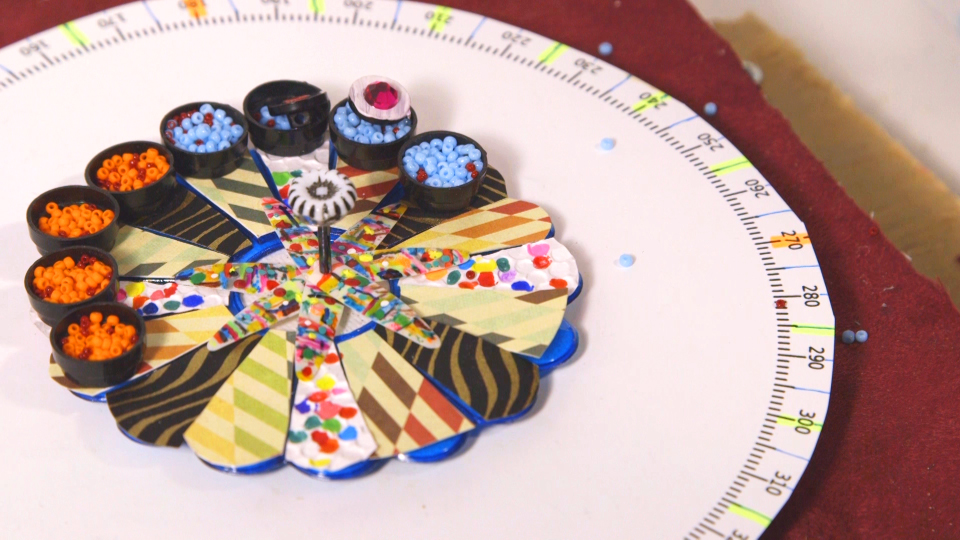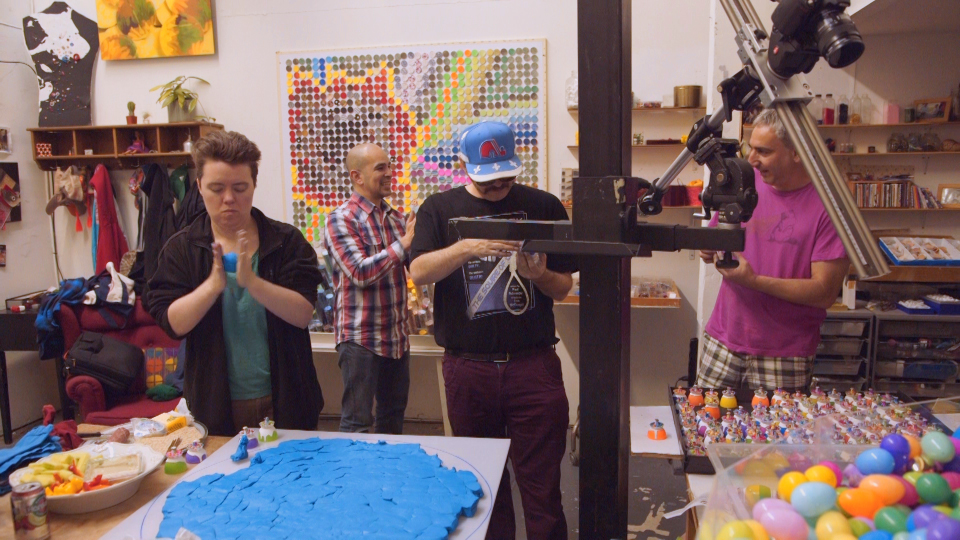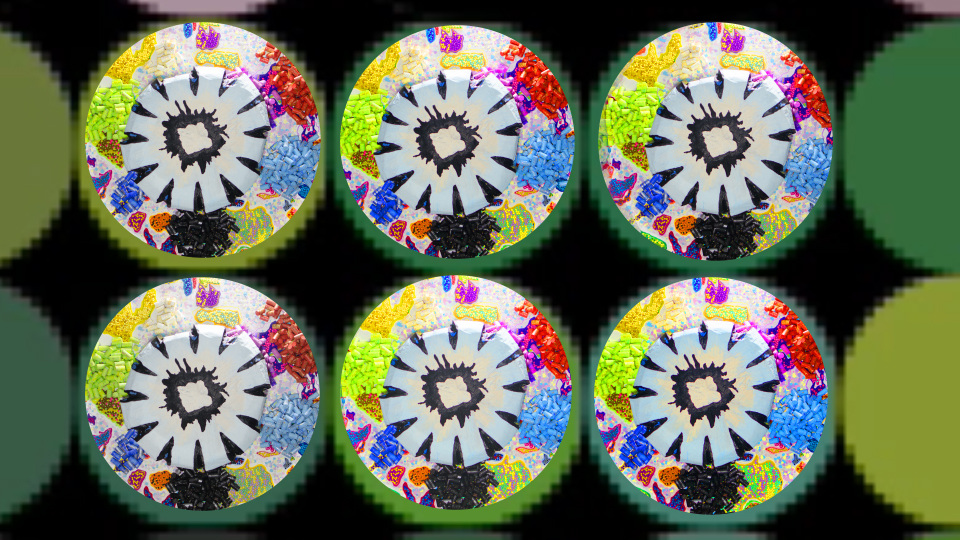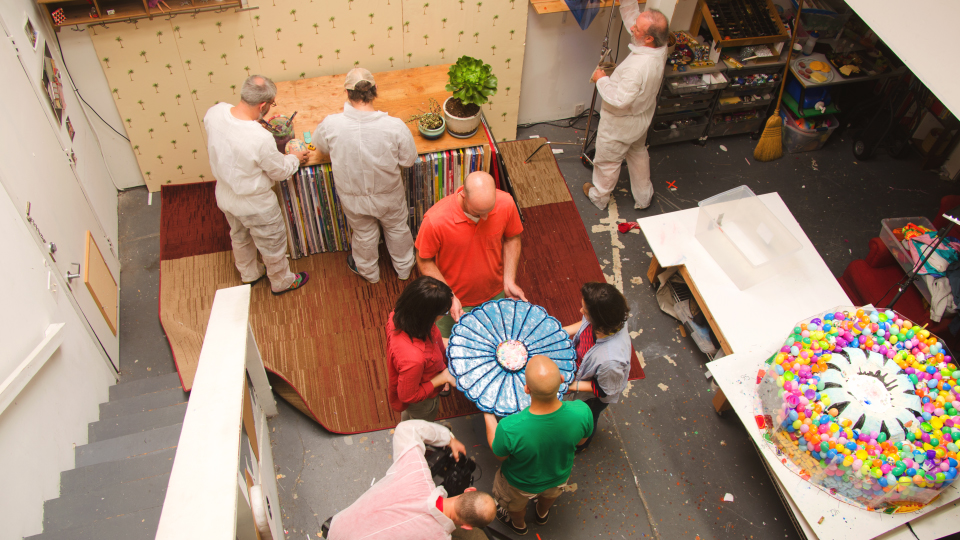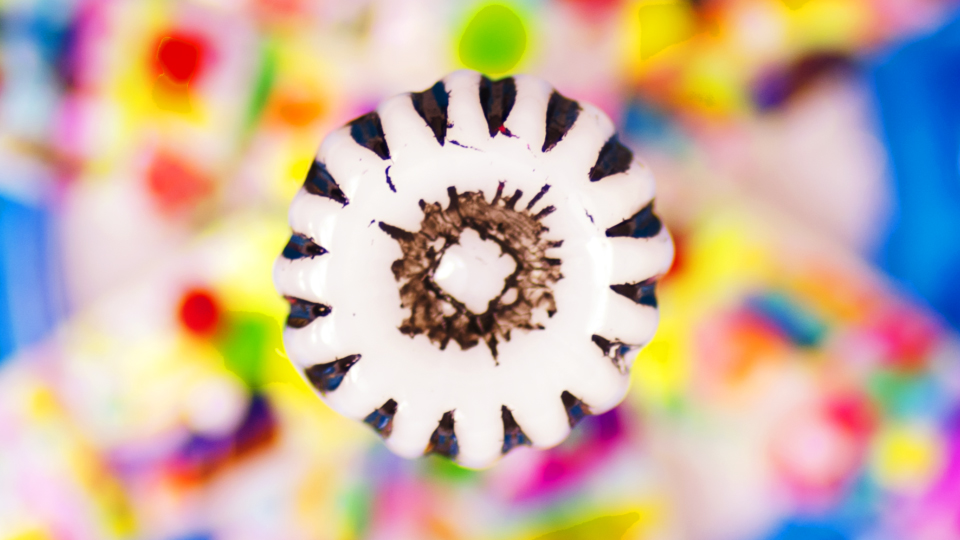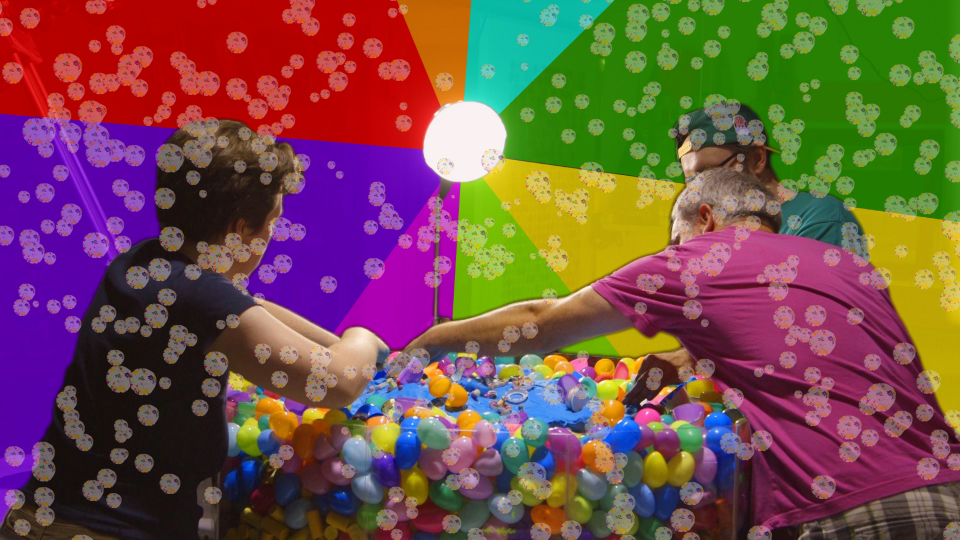FOR IMMEDIATE RELEASE: On July 1, 2015, award-winning visual artist Mike Cantor releases the short film Advanced Doodling, a visually arresting experiment in "meta-stop-motion" animation.
Press Kit Contents:
- Advanced Doodling: A Beginner's Guide
- Highlights
- Doodler in Chief Mike Cantor
- Advanced Doodling: The Art We Make While Making it
- Director Q & A
- Contact
- Film and Production Stills
Advanced Doodling: A Beginner's guide
(top)Once a week for two years, film-maker Mike Cantor invited a team of artists to his Oakland, CA studio to participate in an epic experiment in 3-dimensional doodling. Together, they generated kaleidoscopic moving sculptures in a dazzling variety of media and colors, all animated by stop-motion photography. Cameras also caught the action of the artists themselves, both in documentary footage and through intricately staged time-lapse shoots.
Finally, Cantor spliced the stop-motion footage and the "making of" footage together into an astounding mash-up of process and product: Advanced Doodling.
Advanced Doodling will be released on vimeo.com on July 1, 2015.
Highlights
(top)- Mike Cantor's unique stop-motion films are created by stringing together thousands of still images of multimedia sculptures that evolve over both time and scale.
- Cantor's obsessively curated collection of art materials play a starring role in his films, including tens of thousands of:
- hand-created velcro coins
- painted corks
- decorated easter eggs
- beads and intricate bead sculptures
- Mike Cantor's first two films, "Hot Velcro Action" and the music video "Freckle" screened internationally in over 25 film festivals and won numerous awards.
- Advanced Doodling represents Cantor's most ambitious attempt to present both the product and the process of his unique stop-motion methods.
- Advanced Doodling was created in collaboration with dozens of volunteer co-doodlers, who met once a week for two years to create the artwork used in the film.
- Advanced Doodling was made within the Scary Cow film collective in San Francisco, an organization of over 200 independent filmmakers.
- Advanced Doodling is driven by an eclectic and lively score, including music by Javelin (from David Byrne's record label "Luaka Bop"), Pinky Doodle Poodle, and an original piece created for the film by composer Jared Horne.
- Mike Cantor holds a PhD from Stanford University in Bioinformatics. Professionally, he designs visualization tools for genome sequence data. In his artwork, Cantor employs principles of complexity theory to maximize the visual impact of the patterns he creates.
- Hot Velcro Action, Mike Cantor’s production company, is releasing Advanced Doodling on vimeo.com on July 1, 2015.
Doodler in Chief Mike Cantor
(top)Mike Cantor is an Oakland, CA-based video artist, computational biologist, and pattern junky.
Cantor is best known for his unique experiments in abstract, collaborative stop-motion animation. Over the past decade, he has generated an immense library of "physical pixels" -- hundreds of thousands of hand-decorated velcro coins, painted corks, easter eggs, and tiny bead sculptures in myriad variations. To create his films, Cantor assembles teams of artists to arrange these materials in sequences of patterns which are photographed to generated frames of video. Cantor also use stop-motion animation to document the processes of both "physical pixel" and sequence creation. In "Advanced Doodling", the art and documentary footage are melded together to create a visual feast in which the lines are blurred between process and product.
Mike Cantor's first two short films screened in over 25 national and international film festivals. His first film, "Hot Velcro Action", won Best Experimental Film and Best Visual Effects at the LA International New Wave Film Festival. His collaboration with musician Brandon Patton, entitled "Freckle", won Best Music Video at the San Francisco Frozen Film Festival and was featured on cbsnews.com .
Mike Cantor holds Ph.D. in Bioinformatics from Stanford University. In his day job he works at the Joint Genome Institute, building web-based visualization tools for the analysis of genome sequence data.
Praise For Mike Cantor's "Freckle"
- "It's a freaking mind trip." CBSnews.com
- "A creative blend of the auditory and visual." Gizmodo.com
- "Try to keep it together while watching this incredible animated video, it's a ripping good time!" Neatorama.com
Advanced Doodling: The Art We Make By Making It
(top)Oakland, CA. It's 7:30pm on a Tuesday night in November and Kat Geng is working on an assembly line.
Her job is to glue a white plastic ring around the middle of a day-glo Easter Egg, the type you would crack open to find a prize from a supermarket vending machine. Next to her, Jon Howard affixes balls of colored modeling clay around the edge of the ring. At the end of the line, Matt Fernandez and Franzi Dickson, in turn, attach a white one-inch plastic cone to the top of the egg and decorate the cone with vertical Sharpie lines.
Stop-motion photography catches each tiny step in this process for 180 eggs, generating 400 still images. These stills are combined to create a few seconds of video in which the tiny art objects appear to come to life. Finally, the eggs join 1400 others, get filled with 40 pounds of blue clay, and are arranged by the crew in a huge rotating octagonal sculpture, which is itself filmed in stop-motion over several weeks.
Welcome to the world of "Advanced Doodling", an experiment in collaborative stop-motion animation spanning two years and involving some 20 volunteer artists. The Doodler in Chief is video artist Mike Cantor, and this factory of colorful baubles is his Oakland, CA warehouse studio. Cantor and his army of art elves are all members of Scary Cow, a San Francisco Bay Area collective of about 200 independent filmmakers that join forces to produce each others' films.
The journey begins small. In early 2013, Cantor spends three months working solo to create a tiny evolving sculpture on a rotating blue beer coaster. Gradually adding Scary Cow crew, the project expands into a whorling creative rabbit hole in which visual patterns are spawned and revisited in multiple media and at multiple scales.
The action in the studio is captured on camera in a way that mimics the involuted, self-repeating nature of the artwork. A fixed still camera shoots frames of the artwork itself to create the stop-motion footage. Meanwhile, cinematographer Kevin Jones (Burrito, Slashed) shoots lavish documentary video footage of the artists and their creations. Finally, intricately staged time-lapse rigs capture beautiful moments of process, such as the Easter egg assembly line.
To tell the story of "Advanced Doodling", Cantor takes the project's "meta" nature yet one step further. In a ten minute short film, hundreds of hours of art, documentary, and "process" footage are edited together into increasingly elaborate visual compositions. The story is told in three acts, beginning with his lonely strivings on the tiny blue sculpture, tracking the scale-up in the artwork as he adds crew, and coming to a crescendo in a blistering mash-up of footage that obliterates the line between art and art-making.
"Advanced Doodling" premiered at the Scary Cow Film Festival in San Francisco, where it won the Members Award, Best Visual Effects and Best Editing. The film was also screened at the Windsor Independent Film Festival in the "Films that are visually stunning" category.
Hot Veclro Action productions will release the film publicly on vimeo.com on July 1, 2105.
Q & A With Director Mike Cantor
(top)How did you come up with the idea for "Advanced Doodling"? How did the project come about?
After I finished Freckle [Cantor's music video for Brandon Patton], I was fishing around for the next big project idea. For a few months, I was blocked. To get unstuck I decided to just start shooting... something. My absolute favorite activity in the world is just coming up with cool little abstract stop motion set-ups and tinkering away at them. So this is what I did while waiting for the next Great American Story to come to me. I just doodled away in the studio.
Also, I decided to indulge my obsessive desire to document. I've always been enthralled by all the little set-ups and processes that go in to a shoot. For instance, there is a sequence I call "Volcano" that eventually ended up in Advanced Doodling where a rotating column erupts in this shrapnel of aquarium rocks, splatter-painted disks and shredded paper.
Everything about creating that sequence was gorgeous to me. I wanted to shoot the washing of the aquarium rocks, the painting of the disks, the dicing of the little strips of paper around the column. And of course I wanted to capture the process of the shoot itself: the camera moving on the slider shot by shot, tweezers moving the little rocks around the base of the column... all of it. Every shoot I do, I have this same dilemma -- how much energy do I want to divert from shooting the artwork to capture all of it's beautiful ingredients and by-products? In this "between ideas" time, my mantra was "capture everything".
Finally, I realized that this was actually the film I wanted to make. To share the joy of creating. To shine to the spot-light on my true love: the materials, the processes, the little intermediate doo-dads. To make a love letter to the experience of stop-motion art.
So it started as solitary doodling. How did it turn into a collaborative project?
I've always been into collaborative, semi-rule based art. Over the years I've held a number of stop-motion art parties. It's fun trying think of group shoots that have the right balance of allowing for creative flexibility and producing a cohesive intricate pattern. As soon as I knew that I wanted to make Advanced Doodling I started crewing up and thinking about larger-scale ideas. Then I made my Scary Cow pitch.
Scary Cow?
Yeah, Scary Cow is an amazing organization. It's a group of about 200 filmmakers in the bay area who collaborate to produce each others' films. Every four months there is a "pitch meeting" where members have two minutes each to describe their projects, shooting schedule and crew needs. Then everyone mingles and joins on to the most compelling films. The talent in Scary Cow is incredible - editors, cinematographers, writers, gaffers, sound people, make-up... you name it. At the end of each four month "round," completed films are screened at a film festival at the Castro [the historic Castro Theatre in San Francisco]. The audience votes for their favorite films and the winning directors split a pool of prize money that goes to funding their next films.
So you made your pitch...
Yes. My pitch was kind of unusual. Most pitches sound like "I have these 5 shoot days in May and I need a producer, an editor and two PAs, etc..." In my case, it was "I am going to have an art party every Tuesday night for the 18 months or so... come on by!" I made this same pitch over three straight rounds, so we had this great rotating cast of artist volunteers.
Can you talk about the music in "Advanced Doodling"?
There are three pieces of music in the film, for each of it's three chapters. The first part, "All By Myself," features an abstract sound-scapey score by the composer Jared Horne. It was my first experience getting my animation scored, as opposed to editing to a pre-existing song. Editing animation without an existing soundtrack is a totally different process. For me, the visuals don't come alive without the music. My work has very little native structure (like a story with actors), so the film is really built in the editing room. When I am cutting to music, the music generates the ideas of what to do next and how. So at first it was very challenging, editing to a click-track, and having to kind of just imagine how it would finally play with the score. But I soon realized that this method has it's advantages too. I could completely dictate the trajectory of the art sequence and work with Jared to build the sound in service to that trajectory. In the end, Jared and I worked back and forth very closely, kind of playing hopscotch with the sound edit and the video edit, each building it forward a few steps and handing it off. It was a great experience in collaboration.
For Parts II and III, I used existing songs. In Part II, "Reinforcements" I show the project evolving from a one-man show to a group affair. "Reinforcements" features the song "L'Ocean" by the band Javelin . I got connected to them by the singer Brandon Patton whom I worked with on Freckle. The song is perfect. It's a jubilant, quirky ode to living your best life possible, and it has this great weird atonal bridge that breaks the structure of the song, which made it super-fun to animate to. The band, and Luaka Bop (David Byrne's record label, which signed Javelin) were super-generous to let me use the song for free.
I got similarly lucky with Pinky Doodle Poodle's "1,2,3... Go!" for Part III, "The Last Part", which is the big face-melting mash-up of everything that came before it. Early on I got fixated on the idea of using a Japanese, girl-fronted garage/punk band to match the balls-out furiously gleeful energy of this section of the film. I tried for a while to get the rights to a 5,6,7,8s song [the nineties Japanese trio featured in Pulp Fiction]. But in the middle of this process I discovered Pinky Doodle Poodle and their punky J-Pop sound was right on the money. And again: they and their label amazingly let me use it gratas.
In your day job you work in "bioinformatics". What is that exactly? Does your life in science influence your life in art?
Elviz - A genomics visualization tool designed by Mike Cantor.
Bioinformatics describes the use of computer science techniques to explore biological questions. In my case, I design visualization tools that help scientists explore genome sequence information. My art is definitely inspired by the science that I do. Having spent thousands of hours pouring over plots of scientific data, I have internalized certain visual patterns that show up in my artwork. My thirst for visual pattern is a big part of what draws me to both science and art.
There is a branch of mathematics called "Complex systems" theory. Neurons in the brain, ant colonies, or genetic networks are examples of "Complex systems": groups of a large number of interacting parts, where each part is relatively simple but the "emergent behavior" of the system as a whole can be very sophisticated. Complex systems theory seeks to find common principles of organization that these systems might share. It turns out that complex systems in a variety of domains have a strikingly similar relationship between the number of "parts" and the degree of their interconnectivity. Basically, on the spectrum from chaos to order, there is a small golden window where the most interesting stuff happens. I employ this principle, both subconsciously and deliberately, when building patterns in my artwork. I try to vary statistical distributions across each visual element (color, size, texture, etc...) to hit the randomness "sweet spot" that creates the most visual impact.
Q & Contacts
(top)Mike Cantor:
- mike@mikecantor.net
- 510-495-4094
- twitter: @HotVelcroAction
Advanced Doodling:
- Facebook: Advanced-Doodling
- Hashtag: #Advanced-Doodling
Film and Producton Stills
(top)Click here to download high resolution icons, titles, and production stills for Advanced Doodling.







